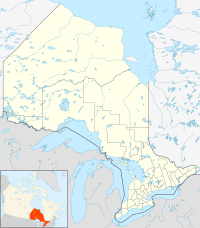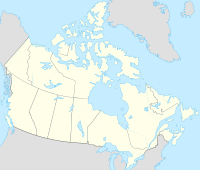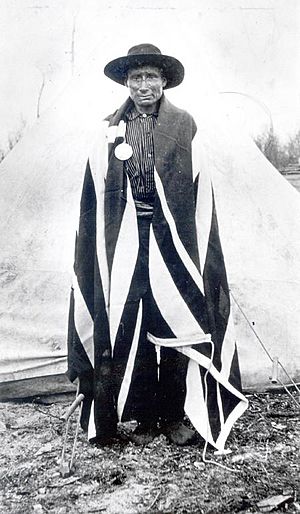Deer Lake First Nation facts for kids
Quick facts for kids
Deer Lake
|
|
|---|---|
| Deer Lake Indian Reserve | |
| Country | Canada |
| Province | Ontario |
| District | Kenora |
| First Nation | Deer Lake |
| Area | |
| • Land | 17.85 km2 (6.89 sq mi) |
| Population
(2011)
|
|
| • Total | 763 |
| • Density | 42.7/km2 (111/sq mi) |
| Website | deerlake.firstnation.ca |
The Deer Lake First Nation (in Oji-Cree: ᐊᑎᑯ ᓴᑲᐦᐃᑲᐣ) is a community of Oji-Cree Indigenous people located in Northern Ontario, Canada. It is found north of Red Lake, Ontario. This First Nation is one of the few in Ontario that signed Treaty 5. It is also part of the Keewaytinook Okimakanak Council (Northern Chiefs) and the Nishnawbe Aski Nation. As of December 2007, the community had 1,072 registered members. About 868 of these members lived on their reserve land. The Nishnawbe-Aski Police Service, a police force for Indigenous communities, helps keep the peace in Deer Lake.
Contents
Speaking the Language of Deer Lake
The people of Deer Lake are closely connected to those from Sandy Lake First Nation and North Spirit Lake First Nation. These three communities speak a special form of the Anishinaabe language. It is often called Oji-Cree language.
In their own language, the people of Deer Lake call themselves Anishinawbe. In English, many prefer to be called Oji-Cree, while some still use Cree. The term Ojibway is mostly used for Native people living further south.
How People Use Their Language
In 2001, data showed that 68% of Deer Lake residents learned their native language first. The rest learned English first. You can hear both languages spoken in daily life. Older community members mostly use their native language. Younger members, especially teenagers, mostly use English. Many adults can easily switch between both languages.
To help keep their language alive, the local schools have started special programs. These programs teach young children in preschool, kindergarten, and early elementary grades using only the native language.
Writing the Language
Learning to read and write the native language using Cree syllabics is also important. Local schools and churches teach this. Since Christianity came to the area in the early 1900s, Deer Lake has used its own style of syllabics. This style combines some sounds and has different endings compared to other versions used in Ontario and Manitoba.
Deer Lake Reserve and Travel
The Deer Lake Reserve covers about 1,653.6 hectares (about 4,086 acres). This land is part of the territory described in Treaty 5. The main community of Deer Lake is located on this reserve.
Getting Around
Deer Lake is connected to Pikangikum First Nation, Sandy Lake First Nation, and North Spirit Lake First Nation by special winter or ice roads. These roads can only be used when the ground is frozen. For year-round travel, Wasaya Airways provides regular flights to and from the Deer Lake Airport.
Early History of Deer Lake
For a long time, the people of the Deer Lake area moved around a lot. Like all Anishinaabe people, they organized themselves by doodem (clan). Small groups of families would set up camps for different seasons. They moved to find the best places for hunting and fishing.
When the Hudson's Bay Company set up fur trade posts in the 1700s, life changed a little. People focused more on trapping animals for trade. But the Deer Lake area was hard to reach for traders. Only the men who took furs to distant posts had contact with non-Indigenous people.
Changes in the 1800s
By the 1800s, too much trapping and changes in the fur trade caused problems. There were fewer fur-bearing animals in the forests. The Hudson's Bay Company even closed some posts. This led to hard times, and many people faced hunger and sickness.
When the Hudson's Bay Company returned later in the 1800s, they gave family names to each clan. For example, the Pelican clan became the Meekis family. The Sucker clan became the Fiddlers and later the Quills. These names were first used for trading. Later, they became official when census records were made. Today, they are common last names in Deer Lake.
A Time of Independence
Around 1900, the people of this area were among the last Indigenous groups in North America living without much outside influence. Christianity and Canadian laws had almost no impact. Under Jack Fiddler, a powerful ogema (chief and spiritual leader) of the Sucker clan, the people continued their traditional way of life.
However, this began to change. In 1906, officers from the North-West Mounted Police arrived. They came to arrest Jack Fiddler and his brother Joseph. This was the first time many Deer Lake people had seen a non-Indigenous person. The elderly Fiddler brothers were charged with murder for killing someone they believed was controlled by an evil spirit during a time of great hunger. They were taken away.
Deer Lake in the Reserve Era
In 1910, Robert Fiddler, Jack's son, signed Treaty 5 at Deer Lake. This began the official relationship between the Deer Lake First Nation and the Government of Canada and the British Crown. After this, the Fiddlers and many others moved to Sandy Lake for better farming land. Others went to North Spirit Lake.
At this time, only the Meekis, Rae, and Quill families still lived at Deer Lake. The total population of the "Deer Lake Band" across all three locations was 78 people. But this number grew as newcomers arrived from Island Lake in Manitoba. By 1929, the population was over 300.
That year, officials from the Government of Ontario decided that the Sandy Lake settlement was part of Treaty 9. They created a reserve for the Deer Lake Band at Sandy Lake Narrows. However, they did not create a reserve at Deer Lake, even though many band members still lived there.
Modern Times
As the 20th century continued, the people of Deer Lake had more contact with the outside world. Cree missionaries brought Methodism and Anglicanism. Local people, led by Adam Fiddler, built churches. As Jack Fiddler had predicted, airplanes began to arrive. Children were taken away to residential schools.
A Hudson's Bay Company store and post office were set up. Oscar and Jeanette Lindokken, who were non-Indigenous, started a nursing station. During this time, the people of Deer Lake lost some of their traditional ways and rights. But in other ways, they kept or changed their cultural practices.
In 1985, the Deer Lake First Nation officially separated from the Sandy Lake First Nation. Both communities became independent bands. However, they still have close ties because of their shared history and family connections.
Transportation
The community is served by the Deer Lake Airport.
Media
- CH4113 TV, Channel 12 - a station that re-broadcasts CBLT-DT
- CIDE-4 FM, 91.9 - a station that re-broadcasts CIDE-FM
- CKDL FM, 90.1 - part of the Wawatay Radio Network




